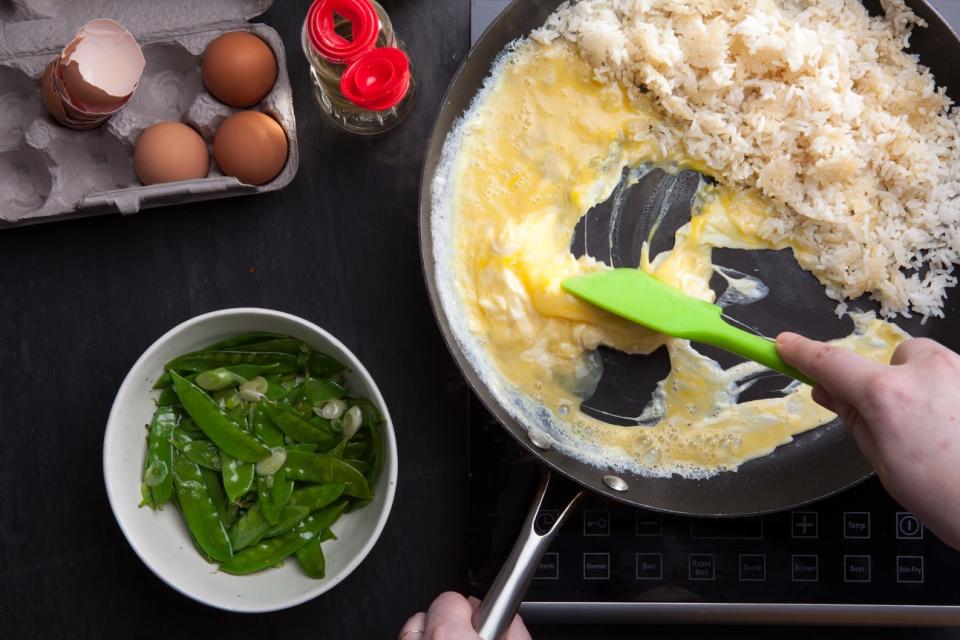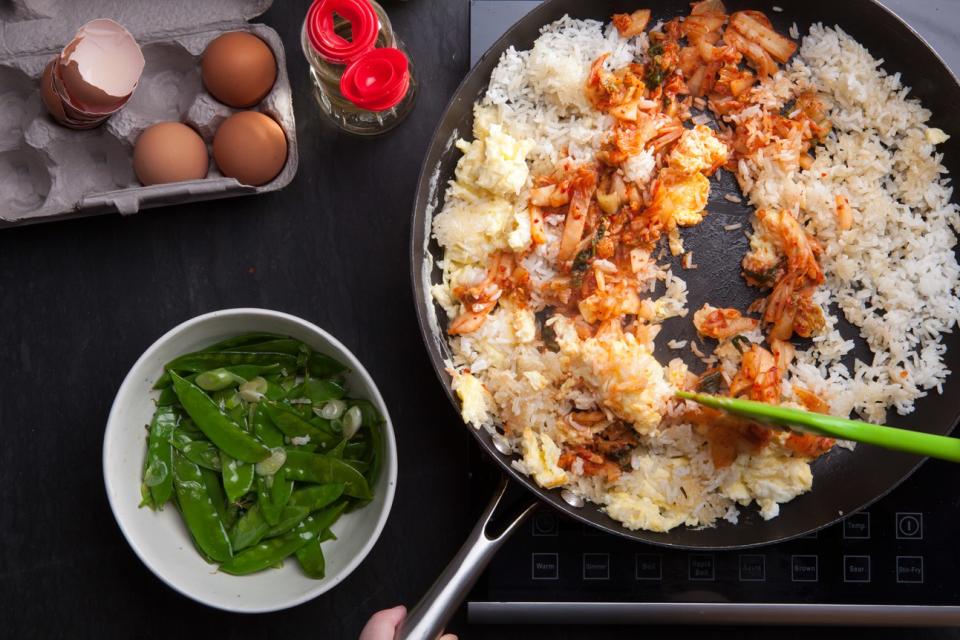How to Make Fried Rice That's Super-Crispy (Meaning Extra-Delicious)
There’s something about crunchy rice that’s really satisfying. That’s why crunchy-bottomed rice dishes are such a crowd-pleaser the world over. Think about the tahdig on Persian rice, or the socarrat on paella. Fried rice is no exception. In order to learn how to make fried rice that's truly crave-able, there's one key trick you need to know: how to make sure those rice grains are a bit crispy.
It might not be obvious when digging into that pile of pea- and pork-studded goodness at your favorite Chinese restaurant, but the grains of rice in stir-fry should be both soft and ever so lightly toasted, so that they remain separate and distinct, not mushy and clumpy. And achieving that perfect balance requires paying close attention to details. Luckily, I wrote an entire book on the subject (Fried Rice: 50 Ways to Stir Up the World’s Favorite Grain), and let me tell you, I learned some things.
To help you go freestyle with your fried rice, I broke down the secrets to success into five easy rules.

No Recipe Required Fried Rice 1
1. Use Cold, Cooked Rice
Warm, freshly cooked rice will stick to the pan and turn mushy. Period. You can add buckets of oil to loosen it, but you’ll only end up with a grease bomb.
But when cooked rice is chilled in the fridge, it undergoes a magical transformation called retrogradation. The starches in the rice that absorbed water and swelled up during cooking will contract as they cool, trapping the moisture into microscopic crystals. This makes the surface of the rice feel hard and dry, but the rice technically isn’t dried out. Instead, it has now reached the perfect state that will allow it to sear and lightly toast while stir-frying, keeping the individual grains loose and separate and yet soft and tender. It’s like a gift from the gods of leftovers.
So plan ahead for your fried rice: Cook your rice the day before and fridge it. Better yet, pack it into freezer bags (in 2 or 4 cup portions depending on if you want to 2 or 4 servings) and freeze so you always have it on hand. Just give it some time to thaw before using. If you add whole bunch of frozen rice to your pan you run the risk of mushitude, since it’ll reduce the temperature and the rice won’t sear like it should.
Still, if you’re really in a hurry, you can use just-cooked rice—just speed up the retrogradation process by spreading it on a baking sheet and freezing an hour or so until cold. And of course, leftover takeout rice that you already have stashed in the fridge will work just as well, but if it's just a day or two old. After that, it'll be too dried out for fried rice.
2. Sauté Ingredients Separately
Fried rice is technically a stir-fry. In other words, it’s a collection of ingredients sautéed at really high heat to not just cook, but also sear. And there’s one trick to searing: don’t rush it. If you throw in all the ingredients at once because you want to get it over with, you’ll lower the temperature in the pan and cause them—and the rice—to essentially steam and turn bland and flabby. And that's the opposite of the lovely crispiness you crave.
So don’t crowd the pan. Instead, sauté various elements like the beaten egg, green vegetables, and aromatics in batches, transferring items to a plate or bowl as you go. Ingredients that take the same amount of time to cook can go together. There’s almost always onion and garlic, but if you’re adding, say, bok choy, cut the longer-cooking stems from the shorter-cooking leaves and sauté the stems separately. Give each ingredient the respect it deserves to bring out its best, then you can combine it all together at the end.

No Recipe Required Fried Rice 2
3. Let The Rice Toast
Ok, so you’ve sautéed your veggie and meat ingredients until they're seared and slightly caramelized. Now it’s time to add the rice. Here’s where the most important technique comes in. As the rice warms up again in the heat of the pan, it'll soften, and if you stir too much you’ll make it mushy. This is especially a problem if your stove doesn’t have blistering hot BTUs. Avoid this by tossing the rice rather than stirring—and what's more, don't toss the rice constantly. Instead, give the rice little frequent pauses to interact with the heat at the bottom of the pan. Even through a wooden spatula, you’ll be able to feel the rice go from hard and cold, to soft, to ever so slightly firm again as it stir-fries. The grains will feel distinct and not so delicate. This is how you know it’s gotten a little bit toasted and reached its higher purpose as perfect fried rice. Bonus points if you then press the rice into the bottom of the pan to let it develop a bit of a crispy crust before you turn it out of the pan.
4. Don’t Go Overboard on Sauces
It’s tempting to want to squirt on a whole host of flavorful sauces while the fried rice cooks, but too much liquid will ruin your hard work and make your fried rice sticky. Use just enough to lightly add flavor, and you can always drizzle the finished dish with more.
I’ve learned that you can dress up perfectly cooked fried rice with all sorts of sauces and toppings just like you would a grain bowl, without losing that je nais se quoi that makes it so delectable. In my cookbook, I drizzle fried rice in everything from satay sauce to fry sauce (aka a mix of mayo and ketchup), so you get bursts of flavor without any risk of mush.
5. Add a crunchy garnish
The crunch doesn’t always have to come only from the rice itself. Try topping your fried rice with toasted nuts or chopped fresh lettuce. In my recipe for Vietnamese Pork Meatball Fried Rice, I use teeny tiny meatballs (which are more texturally fun than just ground beef) in the mix, and top it all with crunchy pickled carrots and daikon and fresh sliced jalapeños. My Pad Thai Fried Rice gets a final dose of crunch from bean sprouts and peanuts. And my Koshari Fried Rice features crunchy fried onions alongside the spicy, tomato-y shatta sauce.
Bottom line: If you can't hear your fried rice while you're eating it, you're doing it wrong.
Vietnamese Pork Meatball Banh Mi Fried Rice
Originally Appeared on Epicurious


